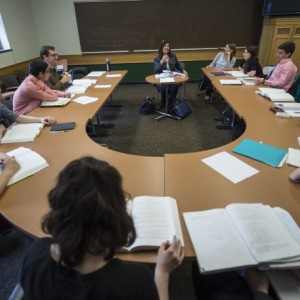During the 2014–15 academic year, the Division of the Humanities will offer instruction in 55 different languages—a typical number at the University. While widely spoken languages like Spanish and Arabic draw the highest enrollments, there are also classes in Georgian, Malayalam, Old Turkic, and other languages classified as “least commonly taught.”
Students from the College, graduate divisions, and professional schools account for nearly 5,000 annual enrollments in language courses taught by a talented corps of lecturers and tenure-track faculty. In 2007 the division established the University of Chicago Language Center to support their efforts and encourage innovative, interactive language pedagogy on and beyond the campus.
With the advent of multimedia and web-based tools and easier access to speakers all over the world, language teaching and learning have moved in new directions. Four longtime instructors spoke with Tableau about their work: Whitney Cox, AM’06, PhD’06, an associate professor in South Asian Languages and Civilizations who teaches Sanskrit; Noha Forster, a lecturer in Arabic and modern languages coordinator in Near Eastern Languages and Civilizations; Ana Maria Lima, senior lecturer and Portuguese language coordinator in Romance Languages and Literatures; and Alice McLean, AM’86, a lecturer in French and Portuguese in Romance Languages and Literatures.
How has language instruction changed since you started teaching?
Noha Forster: I started teaching Arabic at the University in 2002, and we had a relatively small program. But more and more, we found that incoming freshmen had already had two or three years of Arabic in high school. We quickly had to understand this reality and react to it by creating courses at the advanced level.
Ana Maria Lima: The internet has changed the game. We now have online access to things that in the past I would have had to travel to Brazil and bring back: menus, supermarket fliers, videos, magazines, CDs. Our approach, the communicative approach, is to use as many authentic materials as we possibly can. We want to teach the language that people actually speak and use.
NF: I use the internet like I breathe for teaching. Here at the University we teach Modern Standard Arabic, which is in between the classical and colloquial. It allows you to pick up the newspaper and gives you access to most literature. But there’s a built-in conundrum in teaching Arabic and other languages. Students’ different reasons for studying a language often require radically different emphases: some students would say, let’s use the language, while others may say, let’s see how the language works, then use it.
How does the emphasis on speaking proficiency play out in the classroom?
AML: Portuguese is very rich in terms of the grammar, but talking to people on the street, you notice that with verbs, they barely go beyond the present tense and the simple past. People don’t use the subjunctive anymore—but you have to teach that because it’s in the written language.
Whitney Cox: There’s an attempt to make Sanskrit into a modern spoken language. It’s one of the official languages of India, and there is a nightly news broadcast on All India Radio in Sanskrit. But it’s not the same as the written language. Because Sanskrit is intensely grammatical, I’m kind of a stick-in-the-mud. In class we do things that are still done in Sanskrit language schools in India—memorization and recitation—and the students like that.
Alice McLean: My colleagues Nadine Di Vito and Claude Grangier in Romance Languages and Literatures have been working on an innovative method that comes out of this idea of authenticity, that goes back and forth between what is written in French and what has now been lost in oral speech.
NF: I created a listening course, Arabic in Social Context, for advanced students. Students listen to various authentic speech episodes, noting code-switching between formal and colloquial Arabic and asking why people do that. They also note gendered language, youth language, and rural-urban differences.
What things have not changed about language teaching? What’s hard for students?
AML: Students have to learn vocabulary and the alphabet. They have to learn how to conjugate the verbs. They have to learn what the object pronouns are when they’re reading a text. Whenever I stop the class to teach a grammar rule, I usually say, “OK, I’m going to teach you something that you’ll never use, but you should be able to recognize it when you see it.”
WC: Having to teach people a nonnative script can be a nearly insurmountable challenge at the very start. Written Sanskrit also reflects the way that the sounds combine between and within words. People come in to the class and they’re so enthusiastic, and during the first weeks it’s a process of trying to get over this initial set of challenges that are completely outside of their experience, even if they’ve studied other languages before.
NF: There are challenges for teachers too. A first-year language class meets five days a week, so it becomes incumbent upon you to be a kind of entertainer. You have to love what you’re doing enough to be flamboyant and theatrical about it and to solicit that from students.
What is most satisfying to you as a language teacher?
AM: Being in the classroom is usually really fun. When it’s all working there’s a lot of interaction and yet we’re being efficient: we’re moving forward, everybody’s learning, and you can see and measure progress.
AML: You don’t even know how it happens. A professor of mine used to say, “It has not become soup yet,” and then he would say, “Now it’s soup.” You keep adding the elements. In the beginning a class is dependent on the instructor, and slowly it shifts and becomes more about the students. They are producing more, they are talking among themselves, and you see the community forming. I love that.
NF: In the language classroom, we also have the privilege of conveying the culture. It’s a good place to get something that you can’t in other classes.
WC: The first and second—and probably the third and fourth—year of Sanskrit are such a slog. But that moment of conveying the pure joy that I take in my subject to other people—there’s nothing else like that professionally. Even for students who are just starting out, whether it’s the structure of the language itself or being able to convey something about the civilization, that’s the best part of my job.



Add new comment